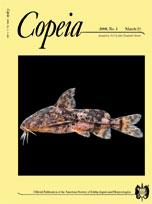This study explored how historical and current hydrological conditions covaried with colonization and occupancy probabilities for 14 pond-breeding amphibians at 32 natural sinkhole ponds over a five-year period. Occupancy and colonization were estimated independently for breeding adults and juvenile recruits (metamorphs) of each species using proportion of area occupied (PAO) models that incorporated species detection probabilities. Model selection revealed whether historical or current hydrological conditions are more important in determining occupancy and colonization probabilities for each species. Adults and metamorphs of ranids and most salamanders had occupancy and colonization rates that were best estimated by models that incorporated each pond's historical hydrology. A comparison of colonization and occupancy dynamics for history dependent species indicates that these species contribute little to species turnover within local pond communities. Adult occupancy and colonization of hylid, bufonid, and a pelobatid species were more dependent on the immediate hydrology of a pond within a year. Recruitment dynamics of these same anuran species were best fit by models that incorporated both current and historical pond hydrology. In some years, these species had high probabilities of producing metamorphs in ponds where they had not produced metamorphs in the previous year. Increases or stability in colonization probabilities between years sometimes coincided with stable occupancy probabilities, indicating that these opportunistic species are responsible for species turnover in local communities. Short-term species turnover within local amphibian communities appears to be driven by these opportunistic species and linked to major changes in weather between consecutive years.
How to translate text using browser tools
21 February 2008
Role of Current Versus Historical Hydrology in Amphibian Species Turnover within Local Pond Communities
Don R. Church
ACCESS THE FULL ARTICLE





